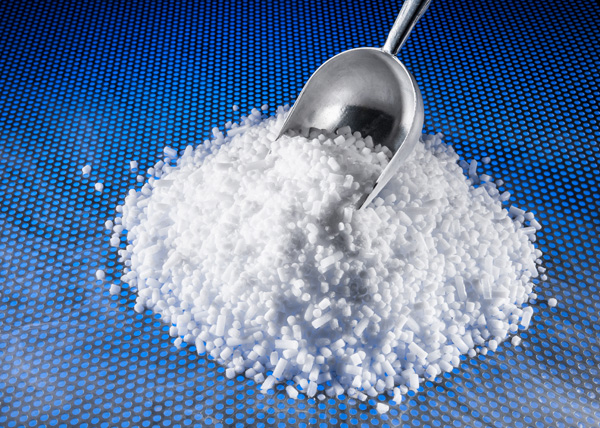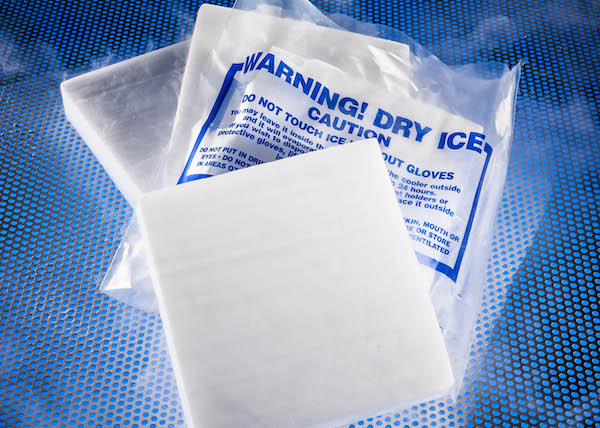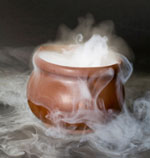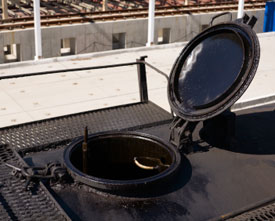Types of Dry Ice
Continental Carbonic offers cut block dry ice and pellet dry ice for sale to consumers. We have dry ice locations in the U.S. and Ontario, Canada where the public can purchase dry ice on a walk-in basis.
Shipping with Dry Ice
Frozen and perishable food can be safely shipped using dry ice. Dry ice keeps shipments cold, saving product waste and money. With three times the pound-for-pound cooling capacity of ordinary wet ice, dry ice is very cost-effective. The main advantage of shipping with dry ice is that unlike water, dry ice does not convert to a liquid state. Instead, dry ice sublimates, i.e., turns directly from a solid to a gas. When a product is shipped with dry ice, the packaging material and the product itself will not be saturated with water.
There are special container systems for shipping with dry ice. Foods such as cheesecake or steaks are protected by the dry ice ship container. Continental Carbonic has Styrofoam™ coolers and other shipping containers available for purchase.
Certain simple steps must be followed for the safe and responsible use of dry ice. Dry ice risks include explosion and skin contact hazards. These risks can be properly managed by following the basic rules for shipping with dry ice.
- Gas Venting – Packages must allow for release of carbon dioxide gas. The dry ice cannot be sealed in a container with an airtight seal.
- Package Integrity – The packaging must also have the ability to withstand the loading and unloading process. The container must also close properly in order to prevent loss of contents that is caused by vibration and/or changes in temperature, humidity, or altitude. Plastics can be damaged or weakened by the use of dry ice and should be avoided.
- Proper Labeling – Be sure to check with your carrier for proper labeling instructions.
- Proper Handling – Gloves should always be used when handling dry ice.
The United States Department of Transportation (DOT) and the International Air Transport Association (IATA) set federal rules that govern the shipment of dry ice.
For air transport, the amount of dry ice per parcel is limited to five pounds or less. In general, poundage is unlimited for ground shipments. Shipments containing dry ice must carry a Class 9 DOT miscellaneous hazardous material warning label and must be clearly marked “Carbon Dioxide Solid, UN 1845” or “Dry Ice, UN 1845.”
Links for shipping with dry ice, information and regulations:
- The US Postal Service Guidelines for Shipping with Dry Ice
Scroll to 10.20.4 to find Dry Ice Guidelines - FedEx (USA shipping) Guidelines for Shipping with Dry Ice
- UPS Guidelines for Shipping with Dry Ice
When using dry ice for shipping, it is important to determine how much dry ice is needed to maintain the proper temperature throughout the entire shipment. Continental Carbonic’s helpful staff can advise on specific dry ice recommendations based on products and shipping conditions.
Safe Handling
Handling
Dry ice is -109º F, which is cold enough to freeze skin cells causing an injury similar to a burn. Never allow dry ice to come in contact with skin. Always handle dry ice with protective gloves or a towel.
Ventilation
Dry ice converts to carbon dioxide gas. If left in a confined space, the carbon dioxide gas will displace oxygen and present a suffocation hazard. If dry ice has been in a confined space (e.g. a closed car or room) for more than 10 minutes, open the doors and windows before entering or you could experience difficulty breathing. Leave the area immediately if you start to breathe quickly or have any difficulty breathing.
Storage
Do not store dry ice in a container that is completely airtight. When dry ice sublimates to carbon dioxide gas, the gas pressure greatly expands. This expansion will cause an airtight container to expand and possibly explode.
For a copy of our dry ice safety brochure, click on the appropriate link below and print:
Safety Brochure (English)
Safety Brochure (Spanish)
Uses and Applications
How to Make Dry Ice Fog
To create a fog effect with dry ice, you will need:
- A large container
- Hot water
- Dry ice
Make sure to follow all dry ice Halloween Safety precautions.
Fill a metal or plastic container half full of hot water and add a few pieces of dry ice every 5-10 minutes. As the water cools, you will need to add more hot water to maintain the fog effect. As a rule of thumb, one pound of dry ice will create 2-3 minutes of fog effect. The hotter the water, the more fog, but the quicker sublimation of the dry ice.
When you place dry ice into warm or hot water, clouds of white fog are created. This white fog is condensed water vapor, mixed in with the invisible CO2. The extreme cold causes the water vapor to condense into clouds. The fog is heavy, being carried by the CO2, and will settle to the bottom of a container. This can be poured out and produce enough fog to fill a medium-sized room with a pound or so of dry ice. Do not allow anyone (including pets) to lie in this fog because too much CO2 is toxic.
To create the Spooky Halloween Jack-O-Lantern with dry ice fog, you will need:
- A large pumpkin
- A large glass
- Hot water
- Salt
- Dry ice
Make sure to follow all dry ice safe handling precautions.
Choose a pumpkin large enough to hold a large can inside. Clean out the pumpkin and carve a friendly or a frightening face. Keep in mind, carbon dioxide fog sinks so more fog will flow out of the bottom.
When you are done cleaning out and carving your pumpkin, fill a large glass about half full with hot water and mix in a cup of salt. Use a glass that is taller than the eyes of your pumpkin in order to get fog to flow through all of the carvings.
Place the glass inside of the pumpkin. Wearing thick gloves, drop two or three large pieces of dry ice into the cup of water and cover the top of your pumpkin. Make sure the lid fits tightly to eliminate air currents dissipating the fog. As the water cools, add more hot water to maintain the fog effect. As a rule of thumb, one pound of dry ice will create 2-3 minutes of fog effect. The hotter the water, the more fog, but the quicker dissipation of the dry ice.
Try blowing up a balloon using dry ice! Dry ice can blow up a balloon by filling it with carbon dioxide as the dry ice sublimates.
How could something as cold as dry ice blow up a balloon?
Remember that dry ice expands into carbon dioxide gas when it sublimates, or turns into a gas. This experiment shows you how that works. Make sure to follow all dry ice safe handling precautions.
What you need for this experiment:
- Balloons with openings large enough to fit a plastic bottle opening
- Empty plastic water or soft drink bottle
- Small pieces or pellets of dry ice
- Gloves and tongs to hold the dry ice
- Two people
What to Do:
- Blow up one of the balloons and tie it off.
- Save the balloon for later.
- Remove the lid of the plastic bottle.
- Have one person hold the plastic bottle upright.
- Using tongs and wearing insulated gloves, take a few small pieces of dry ice and put them into the plastic bottle.
- Fit a balloon over the opening of the bottle.
- Watch the balloon inflate with carbon dioxide as the dry ice sublimates.
- To make the balloon inflate faster, shake the bottle gently.
- When the balloon is fully inflated, remove it from the bottle and tie it off.
- Go and get the first balloon that you blew up with your own breath.
- Toss up both balloons into the air.
Notice how the balloon filled with carbon dioxide gas falls quickly to the ground?
That’s because carbon dioxide is heavier than air.
Wearing insulated gloves and using tongs, pick up a piece of dry ice and touch it to the balloon that you blew up with air (not the one you filled with carbon dioxide). What happens to the balloon?
Can you guess why?
First, dip a spoon in hot water and shake off the excess water. Next press the spoon against the a piece of dry ice. The warm spoon will cause the dry ice to sublimate, or turn directly into gas. The pressure of the gas will lift the spoon off the ice, but the pressure of you holding the spoon down will push the spoon back against the dry ice. This process repeats so fast that a singing sound is produced that varies with the pressure.
Make sure to follow all dry ice safe handling precautions.
Dry ice may be the best way to keep your frozen and refrigerated foods from spoiling in the event of a power outage. At a temperature of -109°F, dry ice can replace the cooling power of your refrigerator or freezer.
During a power outage, place dry ice on the top shelf of the freezer and the bottom shelf of the refrigerator. If you are evacuating an area, dry ice in a cooler will allow you to transport perishable food or medicines while traveling.
Continental Carbonic locations have charts available to help determine how much dry ice is needed.
Take Safety Precautions When Working with Dry Ice during a Power Outage:
- DO NOT store dry ice in an airtight container or in an ice chest with the latches locked. The gas pressure of the sublimating solid dry ice will become explosive. Even if the container does not rupture, the force on the lid or top may be enough to cause severe injury. Leave the lid unlatched.
- Keep the cooler or container in an area with good ventilation. Carbon dioxide is heavier than air and will settle in the lowest areas of a room. The best place for storing a container with dry ice is a garage or a room with a ground-level door or window that can be left open.
- Wrap dry ice in a towel or newspaper before placing on top of items to be kept frozen and below items to be kept cool.
- Do not allow bottles or cans to come in direct contact with dry ice. They will freeze and may rupture as their contents expand. As dry ice sublimates, the gas will carbonate open beverages.
- Dry ice is a solid with a temperature of -109° Fahrenheit. Contact with bare hands or skin may cause severe frostbite. Make sure to follow all dry ice safe handling precautions.
- Do not allow children to play with dry ice.
Dry ice can help cancer patients undergoing chemotherapy treatment. Patients have found the use of super cooled “cold caps” to be an effective way to reduce or prevent hair loss.
Super cooled caps (-20 F to -30F) are worn before, during and after the actual intravenous chemotherapy treatment. The blood vessels beneath the skin on the scalp are narrowed reducing the amount of toxic chemical that reach the hair follicles.
The biggest obstacle is that the caps have to be used at a temperature that normal freezers do not reach. Patients are either required to gain access to a super cooled laboratory freezer or use dry ice.
A not for profit organization, The Rapunzel Project, is devoted to helping cancer patients understand this hair saving treatment.
For low-cost dent repair to your car, try dry ice. Park your car with the dent in the sun and let the dent and surrounding sheet metal warm up. Then, wearing protective gloves, put a small block of dry ice over the dent. The rapid chilling of the metal will “pop” the dent without scratching the paint. Do not touch either the dry ice or the extremely cold body of the car with bare skin.
If there is a crease in the bottom of the dent, or a body support member under it, complete dent repair with dry ice may not be possible. Make sure to follow all dry ice safe handling precautions.
Do you have bed bugs? Find out by making a bed bug trap with dry ice. Bed bugs are attracted to the heat of bodies and to carbon dioxide, which is the gas exhaled by humans and animals. Dry ice is solid carbon dioxide and can be used as bait in a bed bug trap. Make sure to follow all dry ice safe handling precautions.
To get rid of a small population of bed bugs or test to see if you have any present, you can build an inexpensive trap with the following ingredients:
- 2-3 pounds of dry ice
- Plastic pet food bowl
- Insulated beverage cup
- Tape
- Fabric
- Talcum powder
Testing for bed bugs is best done at night, as bed bugs prefer the dark.
On the upturned bottom of the bowl, place a large insulated beverage cup. Using gloves, fill the container one-half full with dry ice. Leave the top open. DO NOT close the container or the dry ice could build up pressure. Turn off the lights and leave the room for an hour or more.
The CO2 gas sublimating from the dry ice will attract bed bugs. The bed bugs will crawl up the sides of the bowl and be trapped in the moat.
Get rid of moths that cause damage to woolens and silks using dry ice. Dry ice placed in “contractor” trash bags can fumigate moths, moth eggs, and larvae, without using harmful chemicals. Just follow the steps below and make sure to follow all dry ice safe handling precautions:
- Place woolens and silks to be fumigated in heavy (3mm) plastic bags.
- Using gloves, wrap 2-3 pounds of dry ice (per 30-gallon bag) in a large rag or old T-shirt.
- Place the dry ice inside the bag with the clothes or other items to be fumigated.
- Tie the bag loosely with a twist tie. Seal the bag loosely enough that carbon dioxide gas can escape as the dry ice sublimates. Do not create an air tight seal!
The moths, eggs, and larvae will suffocate as the oxygen is displaced. When the dry ice has completely sublimated, seal the bag tightly and store the bagged items. Tight sealing of the storage bag after fumigation is important as tiny clothes moth larvae still outside the bag could crawl inside.
With the increased concern about West Nile Virus, using dry ice as mosquito control around our homes and workplaces can be an effective and environmentally friendly method to control mosquitoes.
Scientists have found that carbon dioxide exhaled from mammals by breathing is what attracts mosquitoes. A five-pound block of dry ice hung near a mosquito trap will simulate the carbon dioxide output of a large mammal in one dusk-to-dawn trapping period.
The dry ice should be hung six to eight feet from the ground at about the same level as the trap. Make sure to follow all dry ice safe handling precautions.
Dry ice helps maintain the post-harvest quality of seeds by controlling insects, bacteria, and fungi which attack stored seeds and grain.
As gardens and farms reach full growth, it may be necessary to store seeds and grains after harvest for either future planting or shipping. Depending on need, dry ice can be used on a one-time or regular basis to fumigate stored seeds and grains.
Dry ice can also induce vernalization, which is the prolonged exposure to cold temperatures that some seeds require before they will germinate and grow for the following growing season.
If you are interested in saving small amounts of seed of a favorite plant, information about selecting plants and seed saving can be found at www.seedsavers.org, the Seed Savers Exchange. Make sure to follow all dry ice safe handling precautions.
Cloud seeding with dry ice is used to create rain! Cloud seeding was discovered accidentally in a General Electric laboratory in New York. Below are several interesting cases in which cloud seeding was used:
- In 1946, GE chemist Vincent Schaefer caused a snowfall near Schenectady, NY by dumping six pounds of dry ice from an airplane.
- Cloud seeding was used by the U.S. Air Force in Vietnam to extend the monsoon season.
- The radioactive fallout from the Chernobyl nuclear disaster in Russia was contained and kept from reaching Moscow with cloud seeding.
- Cloud seeding was used in China to reduce air pollution during the 2008 Olympic Games, and it is still used in airports to remove fog.
Dry ice is an innovative way to mark livestock ownership. Instead of hurting and scarring the cattle, freeze-branding causes the hair follicles to produce white hair. This creates a highly visible brand without a scar.
A freeze-branding iron is made from copper with the face (characters) slightly rounded. The cow is herded into a “squeeze chute” where a small area of hair is trimmed very close to the skin and sprayed with alcohol. The branding iron is then pressed onto that small area for about a minute. The freezing alters the hair follicles, resulting in the hair growing out white. The animal feels the cold only briefly because the area is quickly numbed. The branding iron is chilled by immersing it in a mixture of dry ice and 90% alcohol for a few moments until the mixture quits bubbling, indicating that the iron is ready. This is a less cruel and more humane way of branding cattle compared to the traditional hot branding iron.
The old term for death and burial, “pushing up daisies,” may return to popular use. “Green burial” uses dry ice to preserve the human body for a funeral. The body is then buried in a cloth shroud or simple bio-degradable casket in a cemetery, which may look more like a wildflower preserve than a graveyard. Several organizations supporting “Green Burial” believe it is more environmentally friendly than the use of toxic chemicals for embalming and concrete vaults as grave liners. This method is also much less expensive.
Dry ice can be used to remove oxygen from tanks containing flammable solvents, making them safer for repair or removal.
To remove oxygen, first put dry ice pellets or blocks into the filler opening of a tank. Then, place a dry rag into the tank opening. After several minutes, the dry ice sublimates and fills the tank with carbon dioxide gas which displaces the oxygen.
Dry ice can be used to remove oxygen from tanks containing flammable solvents, making them safer for repair or removal.
To remove oxygen, first put dry ice pellets or blocks into the filler opening of a tank. Then, place a dry rag into the tank opening. After several minutes, the dry ice sublimates and fills the tank with carbon dioxide gas which displaces the oxygen.
Asphalt paving work looks rough-and-ready, but it is actually a ballet. The hot mix has to leave the plant at just the right temperature to arrive at the job site ready for spreading. The paving machine needs a constant supply of asphalt from the trucks. The rollers must compact the asphalt effectively to get long-lasting pavement.
Highway agencies establish contract requirements regarding the acceptable compaction and final density of the asphalt paving. This is tested by cutting cores from the new paving for examination in a lab. The coring requirements are very particular in order to prevent damage to the core sample. To cut an undamaged core for testing, the asphalt must cool down. This time delay can be costly to the contractor if inadequate compaction is discovered much later in the lab.
To speed the cooling process and core the paving sooner, contractors use dry ice. The dry ice is not placed directly on the newly-rolled asphalt, because the thermal shock from the extreme cold would put micro-fractures in the sample core. Usually wet ice, left in a plastic bag to keep the asphalt surface dry, is placed between the dry ice and the pavement area. In addition, a mobile testing lab is positioned at the job site to speed up field evaluations.

















